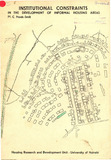| dc.description.abstract | A large proportion of the urban population in almost all developing
countries lives in sub-standard housing, in areas which have been termed
squatter settlements, slums, spontaneous or unauthorised settlements.
These terms describe a variety of different conditions with respect to
standards of housing and services, lay-out, legal status and historical
background. In this paper the term 'informal housing areas' will be
used in order to include all those urban areas that do not comply with
one or more of the existing legal regulations on planning or development
of residential areas.
Recent years have seen a considerable change in official and semi-official
attitudes towards the phenomenon of urban informal housing. There
is increasing awareness that the growth of these housing areas may be
expected to continue for some time to come (the reasons for this have
been considered extensively elsewhere) (1) and that attempts to curb
this development by demolition policies only, seem to make matters worse.
Moreover, a large number of studies on squatter areas and other informal
housing areas have emphasized their positive features. (2)
1. e.g.: Uche, U.U. 1976. The Law, Policies and Rural Urban Migration in
Kenya.
Dwyer, D.J. 1975. People and HOusing in Third World Cities,
Perspectives on the problem of spontaneous settlements, Longman,
London.
2. e.g.: Clinard, M.B. 1966. Slums and community Development. Experiments
in Self-help, The Free Press, New York.
Improvement of slums and Uncontrolled Settlements. United Nations,
1971. ST/TAO/SER. C/124.
Etherton, D. 1971. Mathare Valley. A case study of uncontrolled
settlement in Nairobi. H.R.D.U.
Hoek-Smit, M.C. 1976. The Future Planning of a Majengo, Swahili
Village-Masaku. H.R.D.U. All further references to the Masaku
Majengo are taken from this study. Majengo is the name for
traditional informal urban housing areas founded by moslem
people from the coast at the beginning of this century.
References to Majengo in general are derived from research at
present undertaken by the author, in the Majengo of Murang'a,
Kericho, Kakamega. The research is funded by a grant from the
Netherlands Foundation for the Advancement of Tropical Research (WOTRO) • | en_US |



